
Temporary Calm After Two Weeks of Storm
Last week began with significant trade policy announcements from the Trump administration, including plans to impose tariffs of 25% on imports from Canada and Mexico and 10% on imports from China, effective February 4. While the tariffs on Canada and Mexico were delayed by 30 days, the potential domestic impact of these policies could lead to higher inflation and slower economic growth. On the U.S. data front, most published data missed estimates during the week, but overall, it was positive as we approached the end. Key takeaways included improvements in manufacturing and construction, a cooling service sector, and a resilient yet unpredictable jobs market.
Outside the U.S., the focus was mostly on central banks. Central banks in both emerging and advanced economies cut interest rates during the week. Mexico’s Banxico reduced its policy rate by 50 basis points (bps) to 9.50%, signaling potential further cuts. The Reserve Bank of India implemented its first rate cut since 2020, lowering rates by 25 bps, and the Bank of England also cut rates by 25 bps. Meanwhile, banks are adjusting their risk assessments, with lending standards tightening but at a diminishing rate, as indicated by the Q4 Senior Loan Officer Opinion Survey.
In the week ahead, key economic data releases include U.S. CPI, Retail Sales, and Industrial Production, as well as inflation reports from China and Brazil, and U.K. GDP figures.
U.S. Review and Outlook
As mentioned above, last week started with a tariff storm. Although the implementation was delayed, it had a significant impact—the U.S. dollar index surged toward the 110-mark, while stock markets saw substantial losses. Additionally, Deep Seek news, and its updates affected tech stocks. However, as markets adjusted to the delay and digested economic data, sentiment improved, leading to a recovery in equities. Concerns over a potential trade war are turning into concrete policies, with new tariffs expected to slow down growth and temporarily increase inflation. The U.S. trade deficit also widened sharply in December, ending 2024 with a 17% increase over 2023.
On the data front, the January jobs report showed weaker-than-expected payroll growth of 143K, though December’s figure was revised up to 307K, the largest increase in nearly two years. However, on an annual scale, the labor market is showing signs of cooling. Meanwhile, the ISM Manufacturing Index finally rose above 50 for the first time since 2022, signaling a potential economic rebound, while the ISM Services Index softened, reflecting concerns over tariffs.
The week ahead will be lighter, with inflation data taking center stage, while retail sales and industrial production will also be in focus. The first major inflation report of 2025 is expected to show persistent price pressures, with CPI rising an estimated 0.3% in January, keeping the annual rate at 2.9%. Core inflation is also set for a 0.3% gain, driven by rebounding goods prices and stronger non-housing services. Updated seasonal adjustments could moderate early-year inflation, but rising goods prices and new tariffs may keep inflation steady throughout 2025.
Elsewhere, while retail sales ended in 2024 on a strong note, 0.4% in December, mostly due to holiday sales—2025 could begin with softer spending as consumer confidence weakens and inflation concerns grow in January. Though higher wages can still support spending, potential new tariffs pose risks to consumer activity.
Additionally, while industrial production surged 0.9% in December, marking its strongest monthly gain in nearly a year, annual growth remained weak. January’s production is projected to rise 0.3%, supported by improving manufacturing activity. However, ongoing uncertainties around tariffs and high interest rates could weigh on industrial output in the months ahead.
Looking ahead, inflation remains key, with January’s CPI expected to hold steady at 2.9% YoY. Rising goods prices and new trade policies could sustain inflationary pressures, keeping the Fed in a cautious stance and supporting the dollar’s strength in the near term. From a technical perspective, the DXY remains stable, with strong support at 106.60. A break below 106.6 could shift the short-term trend downward, with 105.50 as the next support level.
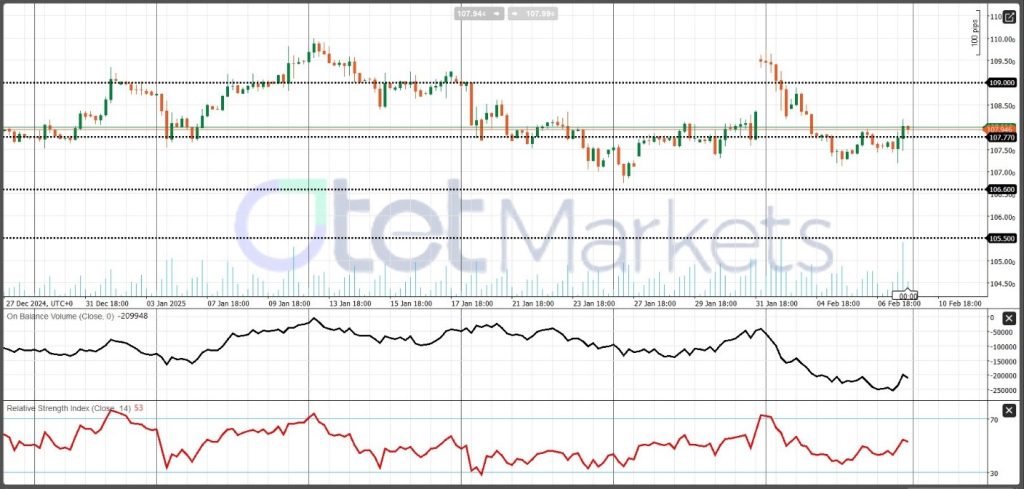
On Wall Street, the S&P 500 faced early-week turbulence but closed higher last week as investors digested economic data and policy updates. The index initially dropped amid trade war fears and a broader market sell-off but managed to recover as sentiment became more optimistic. While strong earnings and continued economic momentum could drive gains, headwinds from persistent inflation, rising tariffs, and interest rate uncertainty may keep volatility elevated. From a technical perspective, the index is losing momentum, with a declining OBV line and a lower RSI. A break below 6,000 could bring 5,930 and then 5,870 into focus as potential downside targets.
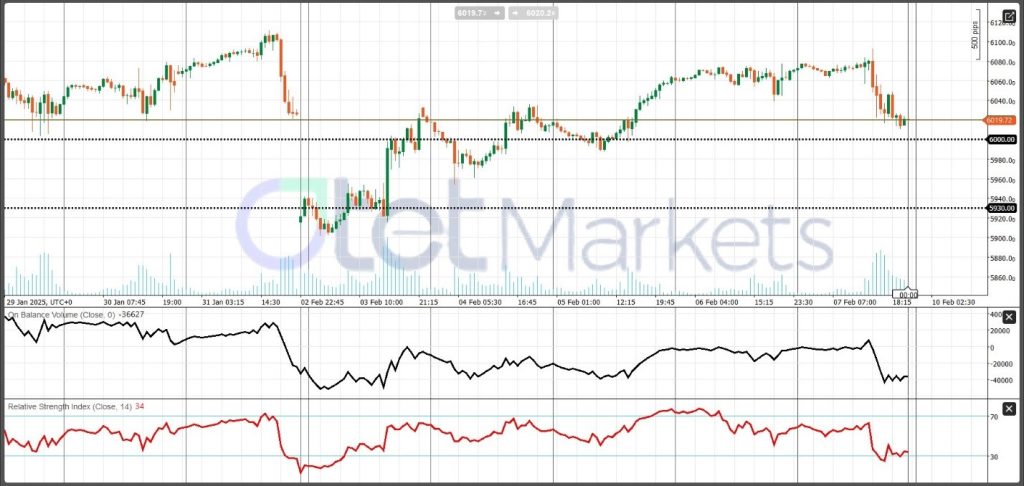
Overall, while the USD remains well-supported by economic resilience and trade uncertainties, Wall Street’s path forward depends on how markets navigate inflation risks and policy shifts.
UK – GDP and Pound Sterling Outlook
The Bank of England (BoE) cut its policy rate by 25 basis points to 4.5%, as expected, citing progress in reducing inflationary pressures. While the central bank signaled a gradual approach to further easing, the unanimous vote for a rate cut stood out, with two members even favoring a 50-bps reduction. The BoE also raised its inflation forecasts for 2025-2027 but halved its GDP growth projection for 2025 to 0.75%. Given these factors, markets are now watching whether the bank will proceed with back-to-back rate cuts in March. For now, the BoE is expected to cut rates by 25 bps per quarter through Q1-2026, reaching 3.5% by year-end. The pound remains under pressure from monetary policy shifts, but upcoming GDP data could determine its short-term direction.
On the data front, last week saw mixed economic figures. Manufacturing PMI beat estimates but remained below the 50-expansion level, while Services PMI missed expectations, dragging down the overall Composite PMI. Following the rate cut, mortgage rates fell slightly to 4.49% in January from 4.50% in December, but labor costs and house prices increased.
Looking ahead, UK Q4 GDP data will be crucial. Economists expect a 0.1% contraction QoQ and 1.1% growth YoY, with December’s GDP rising just 0.1% MoM. If GDP declines more than expected, alongside risks from new U.S. tariffs, expectations for faster BoE rate cuts could rise, further pressuring the pound. Conversely, stronger-than-expected growth could ease recession fears and support the currency.
We expect the BoE’s decision to continue weighing on the pound on a fundamental level, especially as monetary policy expectations may diverge further from the Fed’s. However, if UK GDP growth accelerates, it could provide some support for the currency by easing market concerns.
From a technical standpoint, GBP/USD remains bearish, with a strong pivot at 1.25. A recovery above this key level could shift the short-term trend, but in the bigger picture, the bearish outlook remains intact.
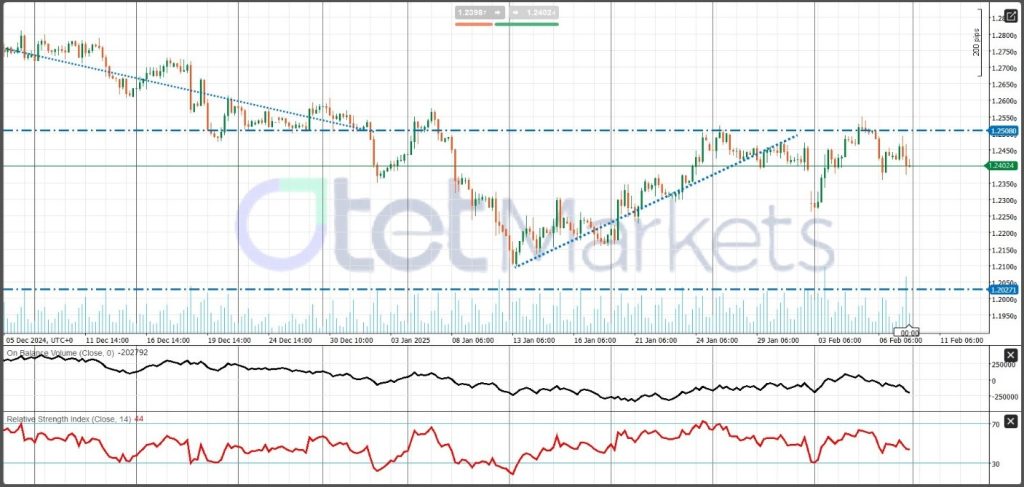
Gold and Trade War
With its sixth consecutive weekly gain, gold has surged to record highs, jumping over 9% year-to-date and reaching an all-time high of $2,882. This rally is driven by gold’s role as a safe-haven asset amid trade tariff uncertainty and market volatility. Unlike Bitcoin, which has behaved more like a tech stock, gold has solidified its position as the preferred safe haven. Analysts suggest that ongoing trade tensions, particularly U.S. tariffs on China and delayed tariffs on Canada and Mexico, could further support gold prices by fueling inflation and slowing global growth.
China retaliated against U.S. tariffs by imposing duties on U.S. goods like coal, LNG, crude oil, and agricultural equipment, while also restricting exports of rare earth materials. These actions, along with Beijing’s antitrust investigation into Google and its blacklisting of U.S. firms, have heightened trade war concerns, boosting demand for gold as a hedge against uncertainty.
While gold may face short-term volatility due to a stronger dollar and inflation pressures, the broader trend of trade-related uncertainty and economic risks is likely to sustain its appeal as a safe-haven asset.
On the other hand, if we consider the higher-for-longer Fed policy, which could increase Treasury yields, it may slow down the bull rally.
From a technical point of view, gold is moving in a clear uptrend. Initial support sits at 2,780, followed by 2,680 as the next support level.
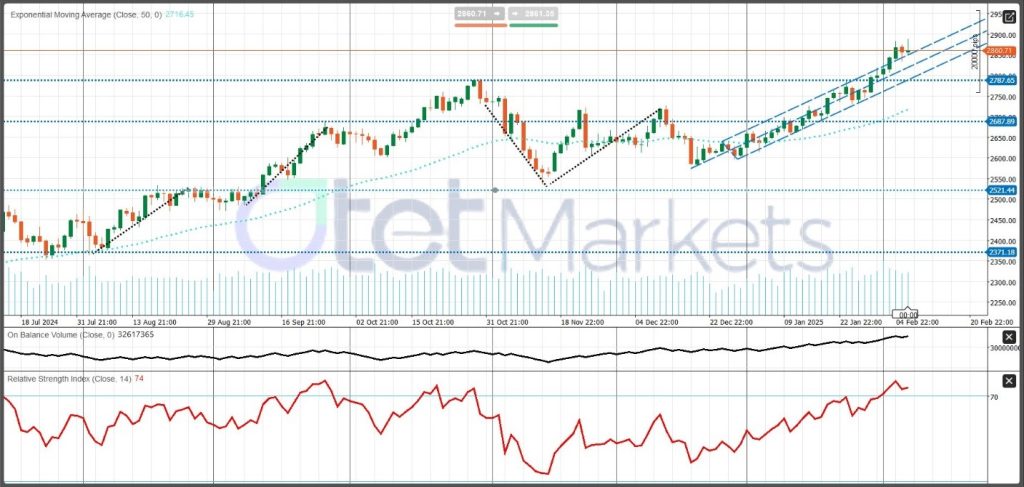
Saudi Arabia Raises Oil Prices
Oil prices recently faced downward pressure due to a drop in U.S. oil inventories, despite U.S. President Trump’s efforts to increase pressure on Iran by targeting its oil exports. Market sentiment was instead influenced by tariff concerns and a weekly inventory report from the EIA, which showed a significant increase in U.S. crude oil stocks (up 8.66 million barrels). This rise was driven by higher imports and stronger oil output, which had recovered after winter storms. While gasoline inventories rose, distillate stocks fell due to cold weather boosting demand.
However, oil prices are holding up today, supported by Saudi Arabia’s decision to raise its official selling prices for crude. Saudi Aramco increased the price of its flagship Arab Light crude for Asia by $2.40 per barrel, reaching its highest level since December 2023.
From a macroeconomic perspective, ongoing trade wars and market uncertainties are not favorable for oil prices, especially as the Trump administration aims to lower energy prices. Recently, at the Davos World Economic Forum, President Trump mentioned that lowering energy prices could encourage central banks to reduce rates and boost the economy.
In terms of economic data, the week ahead will feature the EIA Short-Term Energy Outlook on Tuesday and the IEA Monthly Report on Thursday. The current conditions and outlooks from the EIA and IEA could significantly influence market sentiment.
From a technical standpoint, trading below the initial resistance level of 72.80 keeps oil prices under pressure. The first strong resistance level sits at 72.80 keeps oil prices under pressure. The first strong support level sits at 70. Around 70, the increased market volume could provide a base for a short−term uptrend, with 75 as the target if prices can break above $72.80.
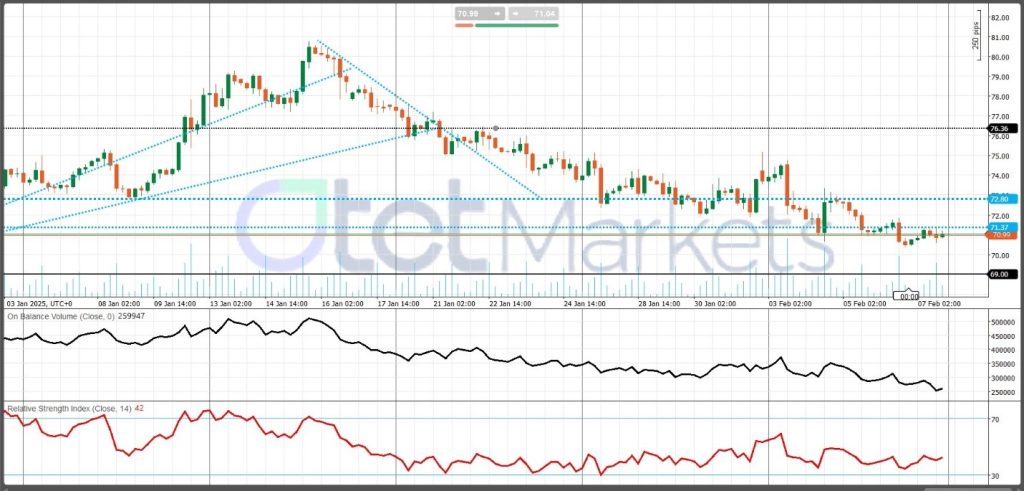
BTC Moves Sideways
Bitcoin (BTC/USD) has been trading sideways since late December 2024, consolidating within a $93,000–$106,000 range after a post-U.S. election rally lost momentum. In contrast, gold has surged to record highs, attracting safe-haven flows, while Bitcoin continues to behave more like a tech stock, underperforming amid market uncertainty.
Bearish pressure increased due to rising U.S.-China trade war risks and the Federal Reserve’s hawkish stance, which dampened investor sentiment. Unlike gold, Bitcoin has been trading as a risk asset, closely correlated with market risk appetite, making it vulnerable to geopolitical and economic uncertainties.
Despite the bearish outlook, some positive developments could support Bitcoin in the long term. BlackRock announced plans to launch a Bitcoin exchange-traded product (ETP) in Europe, potentially attracting significant capital inflows due to its reputation as the world’s largest asset manager.
Technically, after hitting an all-time high of $109,500, BTC has trended lower, testing key support levels, and is now trading between $93,000 and $101,000. A break below $93,000 and the trendline could lead to a deeper sell-off toward $90,000, with the next target around $87,000. On the flip side, a recovery would require reclaiming the 50 SMA and $101,000 to the target $105,000, and then $109,500.
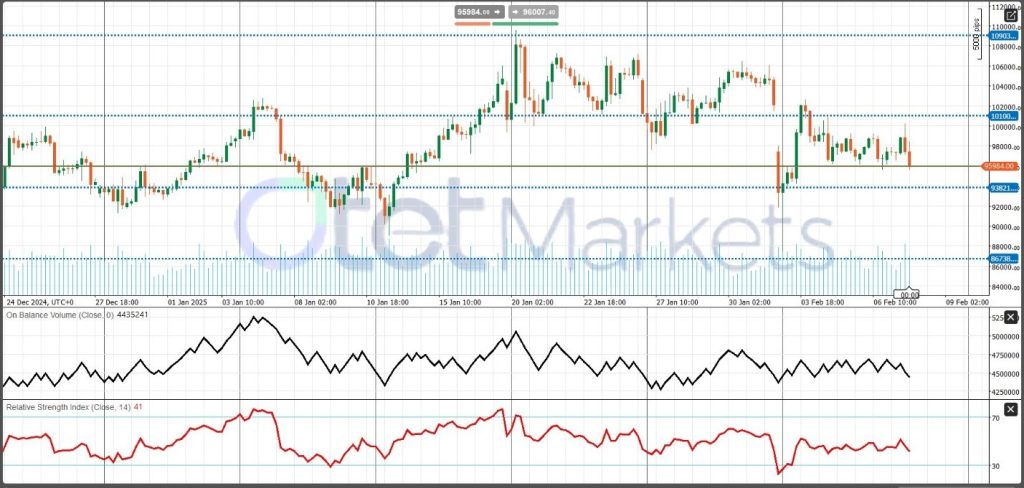
Share
Hot topics
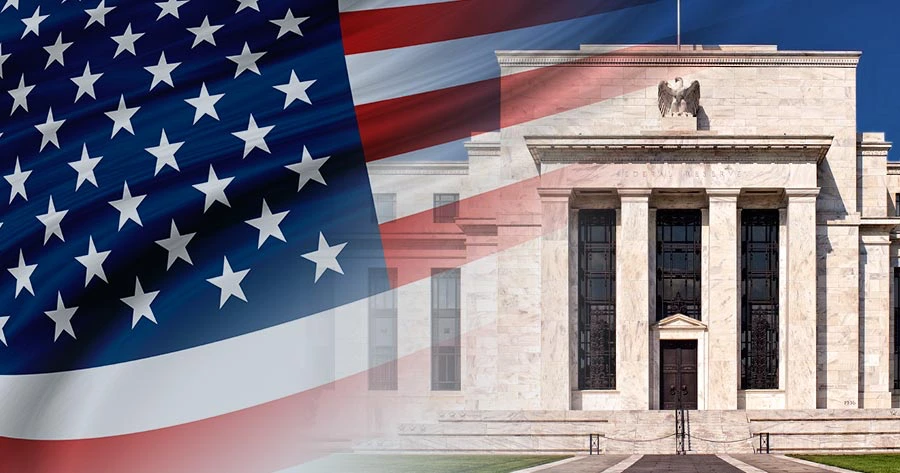
Federal Reserve’s Challenges to Trump’s New Policies
As the Federal Reserve Open Market Committee (FOMC) prepares for its upcoming meeting, all eyes are on how the Fed will respond to Donald Trump’s latest economic policies. With the...
Read more




Submit comment
Your email address will not be published. Required fields are marked *